Chapter 3
Hashing of the Primary Index
“The true index of a man's character is the health of his wife.”
Table of contents Chapter 3 – Hashing of the Primary Index
– The Hash Map Determines which AMP will own the Row
– The Hash Map Determines which AMP will own the Row Continued
– Placing rows on the AMP Continued
– A Review of the Hashing Process
– Non-Unique Primary Indexes have Skewed Data
– The Row Hash and Uniqueness Value make up the Row-ID
– A Row-ID Example for a Unique Primary Index
– A Row-ID Example for a Non-Unique Primary Index(NUPI)
– Two Reasons why each AMP Sorts their rows by the Row-ID
– AMPs sort their rows by Row-ID to Group Like Data
– AMPs sort their rows by Row-ID to do a Binary Search
– Table CREATE Examples with four different Primary Indexes
– Null Values all Hash to the Same AMP
– A Unique Primary Index (UPI) Example
– A Non-Unique Primary Index (NUPI) Example
– A Multi-Column Primary Index Example
– A No Primary Index (NoPI) Example
– Watch the Video on the Hashing the Data
The Hashing Formula Facts

![]() There is only one Hashing Formula.
There is only one Hashing Formula.
![]() A rows Primary Index value is hashed and the output is its Row Hash.
A rows Primary Index value is hashed and the output is its Row Hash.
![]() The Row Hash will be stored with the row (on disk) as part of the Row_ID.
The Row Hash will be stored with the row (on disk) as part of the Row_ID.
![]() If the Hashing Formula hashes value 1001 and gets a row hash of 13 then it will produce a 13 every time it hashes a 1001 value. Its consistent!
If the Hashing Formula hashes value 1001 and gets a row hash of 13 then it will produce a 13 every time it hashes a 1001 value. Its consistent!
There is one Hashing Formula in Teradata and it is consistent. The concept is to take the value of a rows Primary Index and run it through the Hash Formula. It will produce a Row Hash number. That Row Hash will stay with the row forever and reside as the first part of the row. The Row Hash also determines which AMP will own the row.
The Hash Map Determines which AMP will own the Row

This Hash Map is for a 3-AMP system
A rows will be placed on an AMP after the Parsing Engine (PE) hashes the rows Primary Index value. The output of the Hashing Algorithm is a rows Row Hash. The Row hash goes to a bucket in the Hash Map and is assigned to an AMP.
The Hash Map Determines which AMP will own the Row


The above example hashed Emp_No 1001 (Primary Index value) and the output was a Row Hash of 13. Teradata counted over to bucket 13 in the Hash Map and it has the number one (1) inside that bucket. This means that this row will go to AMP 1.
Placing rows on the AMP

The above example hashed Emp_No 1002 (Primary Index value) and the output was a Row Hash of 5. Teradata counted over to bucket 5 in the Hash Map and it has the number two (2) inside that bucket. This means that this row will go to AMP 2.
Placing rows on the AMP Continued

The above example hashed Emp_No 1003 (Primary Index value) and the output was a Row Hash of 9. Teradata counted over to bucket 9 in the Hash Map and it has the number one (3) inside that bucket. This means that this row will go to AMP 3.
A Review of the Hashing Process
![]() Hash the Primary Index Value for a row with the Hash Formula.
Hash the Primary Index Value for a row with the Hash Formula.
![]() The output of the Hash Formula is a 32-bit Row Hash.
The output of the Hash Formula is a 32-bit Row Hash.
![]() Take the Row Hash and find its corresponding bucket in the Hash Map.
Take the Row Hash and find its corresponding bucket in the Hash Map.
![]() Send the row and its Row Hash to the AMP listed in the Hash Map Bucket.
Send the row and its Row Hash to the AMP listed in the Hash Map Bucket.

Take a look at the row hash for each row and notice it corresponds with the Hash Map.
Non-Unique Primary Indexes have Skewed Data
Imagine if we made Last_Name the Primary Index for a table. Here is an example of how it would distribute. Notice all duplicates have the same Row Hash.
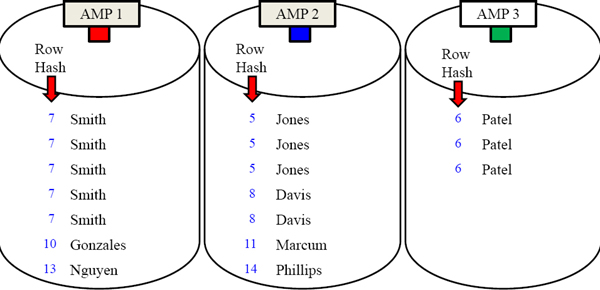
The Hash Formula is consistent so every Smith has the same Row Hash and the same goes for each Jones and each Patel. Therefore duplicate values land on the same AMP.
The Uniqueness Value
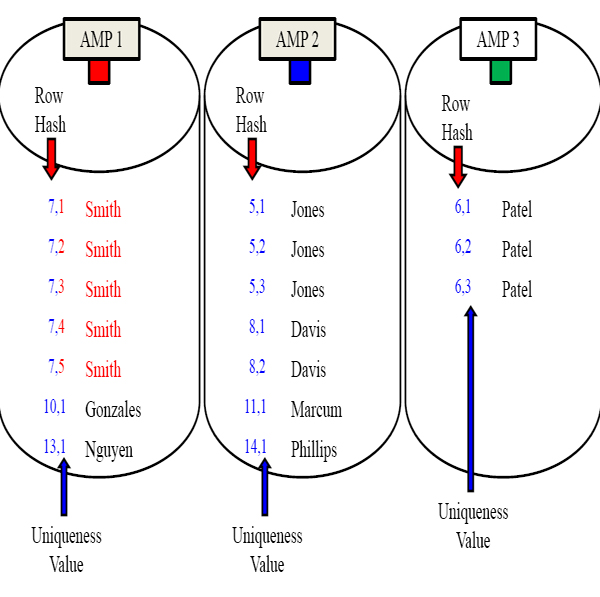
Each AMP will place a Uniqueness Value after the row hash to track duplicate values.
The Row Hash and Uniqueness Value make up the Row-ID
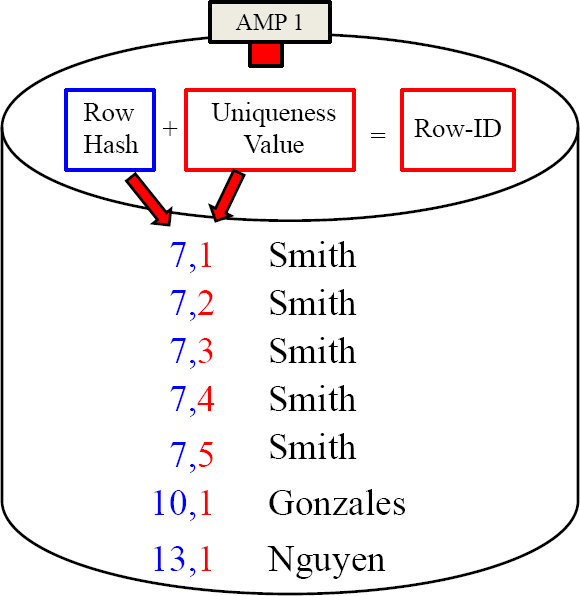
Row-ID equals the Row Hash of the Primary Index column and the Uniqueness Value.
A Row-ID Example for a Unique Primary Index

Notice two things for this Unique Primary Index (UPI) example:
1) The Uniqueness Value on each Row-ID is 1.
2) Each AMP sorts their rows by the Row-ID.
Row Hash and the Uniqueness Value make up the Row-ID. AMPs sort by the Row-ID.
A Row-ID Example for a Non-Unique Primary Index(NUPI)
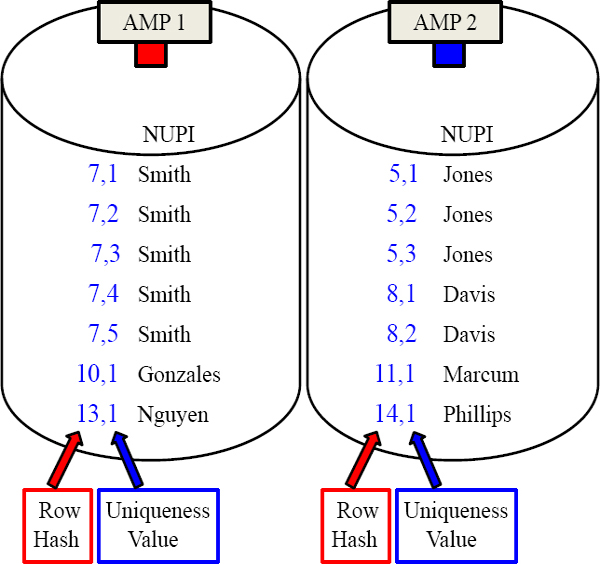
Notice two things:
1) Uniqueness Value increases on all duplicate names.
2) Each AMP sorts their rows by the Row-ID.
Row Hash and the Uniqueness Value make up the Row-ID. AMPs sort by the Row-ID.
Two Reasons why each AMP Sorts their rows by the Row-ID
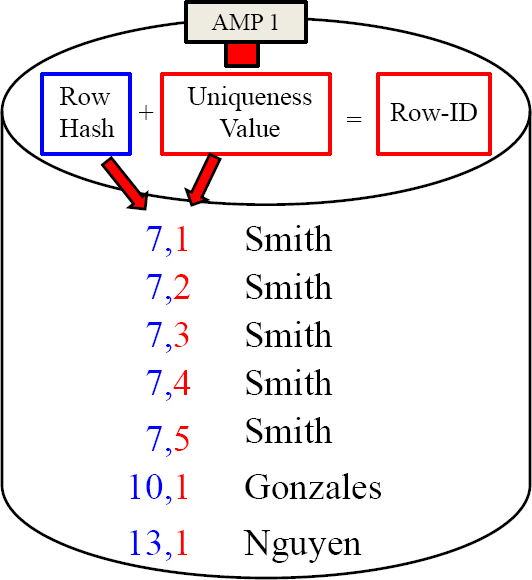
The Two Reasons are:
1) So like Data such as ‘Smith’ is grouped together on the AMPs disk.
2) So each AMP can perform a Binary Search, like a Phone Book in Alphabetical order.
AMPs sort rows by Row-ID so like data is grouped together and for Binary searches.
AMPs sort their rows by Row-ID to Group Like Data

Query
SELECT * FROM Employee_Table
WHERE Last_Name = ‘Smith’ ;
Parsing Engine (PE) Plan
1) I see that Last_Name is the Primary Index.
2) So Hash ‘Smith’ and get the Row Hash.
3) The Row Hash for ‘Smith’ = 7.
4) What AMP# is in Bucket 7 of the Hash Map?
5) Bucket 7 says AMP 1?
6) Bynet – tell AMP 1 to all retrieve Row Hash 7's.
7) Bring back all Columns for Row Hash 7 (‘Smith’).
Notice that all of the Smiths are lumped together because of the sorting by Row-ID.
AMPs sort their rows by Row-ID to do a Binary Search
Query
SELECT * FROM Order_Table
WHERE Order_Number = 50;
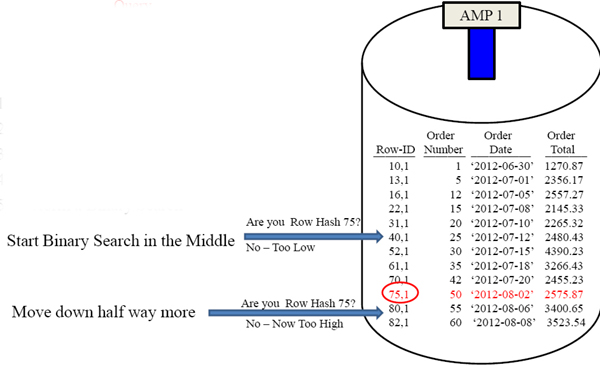
1) Hash Order_Number 50 (Row Hash = 75)
2) Go to bucket 75 in Hash Map
3) What AMP is in bucket 75? AMP 1!
4) Bynet – Tell AMP 1 to get Row Hash 75!
5) Perform a Binary Search
A Binary Search knows the Row-IDs are in numeric order . Its like you using a phone book. Go to the middle first and then go up or down in chunks to find things quickly.
Table CREATE Examples with four different Primary Indexes
![]()
CREATE TABLE Emp_Intl
(Emp_No INTEGER,
Dept_No SMALLINT,
First_Name VARCHAR(12),
Last_Name CHAR(20),
Salary DECIMAL(10,2))
UNIQUE PRIMARY INDEX ( Emp_No );
UPI
![]()
CREATE TABLE Emp_Intl
(Emp_No INTEGER,
Dept_No SMALLINT,
First_Name VARCHAR(12),
Last_Name CHAR(20),
Salary DECIMAL(10,2))
PRIMARY INDEX ( Dept_No );
NUPI
![]()
CREATE TABLE Emp_Intl
(Emp_No INTEGER,
Dept_No SMALLINT,
First_Name VARCHAR(12),
Last_Name CHAR(20),
Salary DECIMAL(10,2))
PRIMARY INDEX ( First_Name , Last_Name );
Multi-Column NUPI
![]()
CREATE TABLE Emp_Intl
(Emp_No INTEGER,
Dept_No SMALLINT,
First_Name VARCHAR(12),
Last_Name CHAR(20),
Salary DECIMAL(10,2))
NO Primary Index
No Primary Index
A table can have only one Primary Index so picking the right one is essential. Above are four different examples for your consideration. Now lets review with these.
Null Values all Hash to the Same AMP

If there are NULL values in the Primary Index you could find this is the reason for your skew. A Table with a Unique Primary Index can have only one Null value, but a NUPI table can have many NULL values and each NULL value hashes to the same AMP.
A Unique Primary Index (UPI) Example
![]()
CREATE TABLE Emp_Intl
(Emp_No INTEGER,
Dept_No SMALLINT,
First_Name VARCHAR(12),
Last_Name CHAR(20),
Salary DECIMAL(10,2))
UNIQUE PRIMARY INDEX ( Emp_No );

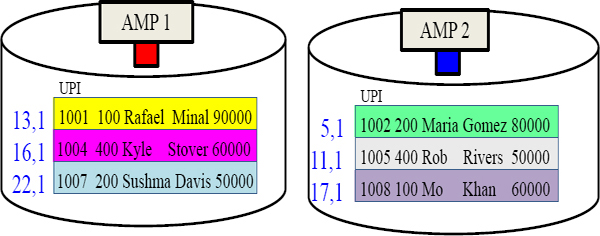
A Unique Primary Index will spread the data perfectly evenly.
A Non-Unique Primary Index (NUPI) Example
![]()
CREATE TABLE Emp_Intl
(Emp_No INTEGER,
Dept_No SMALLINT,
First_Name VARCHAR(12),
Last_Name CHAR(20),
Salary DECIMAL(10,2))
PRIMARY INDEX ( Dept_No );


A Non-Unique Primary Index will NOT spread the data perfectly evenly.
A Multi-Column Primary Index Example
![]()
CREATE TABLE Emp_Intl
(Emp_No INTEGER,
Dept_No SMALLINT
First_Name VARCHAR(12),
Last_Name CHAR(20),
Salary DECIMAL(10,2))
PRIMARY INDEX ( First_Name , Last_Name );


A Multi-Column Primary Index is often used to fix a data skew problem.
A No Primary Index (NoPI) Example
![]()
CREATE TABLE Emp_Intl
(Emp_No INTEGER,
Dept_No SMALLINT,
First_Name VARCHAR(12),
Last_Name CHAR(20),
Salary DECIMAL(10,2))
NO Primary Index


All AMPs read all of their rows (full table scan) because there is no Primary Index.
Watch the Video on the Hashing the Data

Tera-Tom Trivia
In 1980 Tom Coffing won two Olympic Trials before the United States boycotted the Olympics. Tom is pictured above as the wrestler on the left.
Click on the link below or place it in your browser and watch the video on Hashing.
